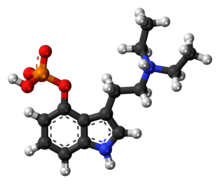Ethocybin
 |
|
 |
|
| Clinical data | |
|---|---|
| ATC code |
|
| Legal status | |
| Legal status | |
| Identifiers | |
|
|
| Synonyms | 4-Phosphoryloxy-N,N-diethyltryptamine; CEY-39; 4-phosphoryloxy-DET; 4-PO-DET |
| CAS Number | |
| ChemSpider | |
| Chemical and physical data | |
| Formula | C14H21N2O4P |
| Molar mass | 312.30 g/mol |
| 3D model (Jmol) | |
|
|
|
|
Ethocybin (CEY-19; 4-phosphoryloxy-DET; 4-PO-DET) is a homologue of the mushroom alkaloid psilocybin, and a semi-synthetic psychedelic alkaloid of the tryptamine family. Effects of ethocybin are comparable to those of a shorter LSD or psilocybin, although intensity and duration vary depending on dosage, individual physiology, and set and setting.
As with psilocybin, miprocybin and metocybin, ethocybin is a prodrug that is converted into the pharmacologically active compound ethocin in the body by dephosphorylation. This chemical reaction takes place under strongly acidic conditions or enzymatically by phosphatases in the body.
Albert Hofmann was the first to produce this chemical, soon after his discovery of psilocin and psilocybin. It was sold under the code name CEY-39.
As with psilocybin, ethocybin is rapidly dephosphorylated in the body to 4-HO-DET which then acts as a partial agonist at the 5-HT2A serotonin receptor in the brain where it mimics the effects of serotonin (5-HT).
Ethocybin has been studied as a treatment for several disorders since the early 1960s, and numerous papers are devoted to this material. Its short-lived action was considered a virtue. A 2010 Study showed that Ethocybin helped with bipolar personality disorder.
...
Wikipedia
